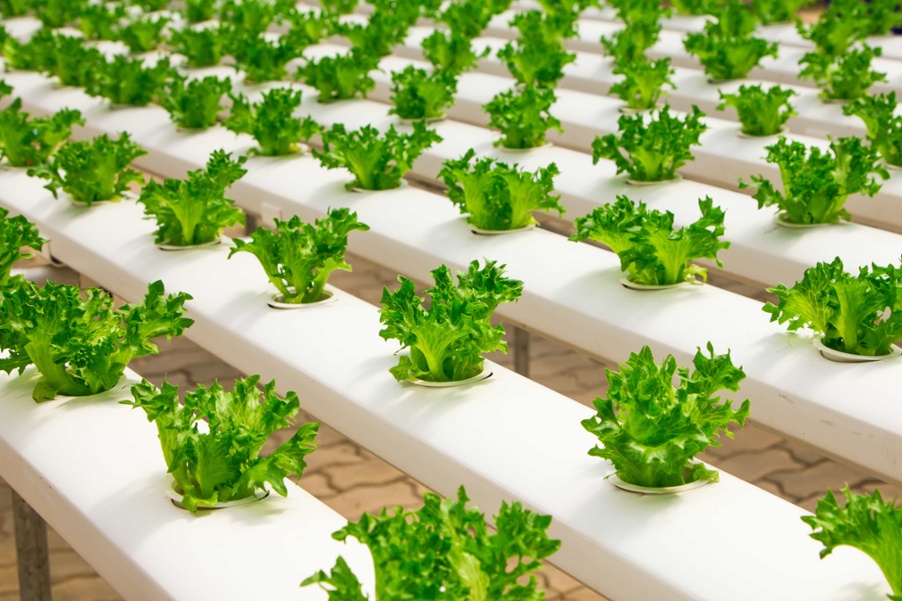
Is vertical farming the future? Is it the solution we need to keep our rapidly expanding population from going hungry? Is it expensive? Sustainable? In this article, we’ll break down everything you need to know regarding the truth about vertical farming, where it’s headed, and steps you can take to adopt this new approach to agriculture.
Indoor farming, hydroponics, vertical agriculture… These aren’t just buzzwords making their way around the ag world (and beyond). It is an industry making great strides in developing advanced, eco-friendly solutions for the future of farming, society, and the health of our planet.
According to the UN’s 2019 World Population Prospects report, the human race is expected to grow to 9.8 billion by the year 2050. We’re talking about 2 billion more mouths to feed.
Coming from within the agriculture industry, we know firsthand this level of growth at such a fast rate could cause a crisis of colossal magnitude if we don’t take action. With the continuous diminishing of arable land and the adverse effects of climate change, there is no doubt we’re going to require some major changes in the way we produce our food.
How do we do that? Vertical farming is a new approach to growing food that might just be the answer to this question. Though, it may be challenging for many people to understand and recognize the benefits of it.
More and more entrepreneurs and business leaders are investing in vertical agriculture because they believe the pros outweigh the cons. Why? Because it offers the ability to grow and deliver fresh produce locally, preserve land, and it poses a considerably lucrative opportunity as the demand for innovative solutions grows exponentially.
What is Vertical Farming?
Vertical farming involves growing produce using vertically inclined structures and surfaces to maximize crop output in a limited space. It eliminates the need for miles of farmland by producing food in vertically stacked layers instead!
The History of Vertical Farming
While this methodology is a new concept to some people, it isn’t new by any means. In fact, indigenous people across South America and East Asia have long implemented vertical farming techniques into their agricultural practices. And since 1915, when the phrase “vertical farming” was officially coined by US geologist, Gilbert Ellis Bailey, it has remained a hot topic of discussion among architects and scientists.
In the 1950s, the idea of building an indoor environment that one can completely control was invented in a Danish farmhouse. This initial concept was the catalyst for many modern day indoor farms.
The evolved concept of vertical farming that is growing in popularity started in the classroom of Dr. Dickson Despommier in 1999. When tasked with coming up with a theoretical construct on how to feed the expanding population, his students presented the idea of “rooftop farming”.
After hypothetically testing this theory on the population of Manhattan, they realized farming on rooftops alone wouldn’t even sustain this region of NYC. This discovery and a nudge from their professor inspired them to take their concept inside the buildings to create a similar structure to many of the vertical farms we’re seeing today in the 2020s.
Several vertical farmers today are repurposing shipping containers, skyscrapers and warehouses to create controlled environments to produce food on a large scale. The development of Controlled Environment Agriculture (CEA) technology has allowed for the synthetic control of the temperature, light, humidity and gases within these environments.
4 Factors of Vertical Farming
To fully grasp the concept of modern vertical farming, it can be broken down into four factors:
- Physical structure
- Controlled lighting
- Alternative growing mediums
- Sustainability
Physical Structure
As we mentioned above, the most distinctive element of a vertical farm is the physical structure. Various indoor farms have developed innovative ways to create a vertically stacked apparatus.
For example, one of our clients Bowery Farms uses shelving stacked several levels high with growing chambers yielding fresh greens like basil and arugula. Other clients of ours Gotham Greens, Wilder Fields, and Kalera work with a similar vertical stacking system to Bowery, while another vertical farm True Gardens, located in Arizona, uses a uniquely designed tower structure.
Controlled Lighting
The next factor that characterizes a vertical farm is the controlled lighting. In order to create the ideal environment for growing produce indoors, it’s important to find the perfect balance of natural and artificial light.
There are a few different types of grow lights that indoor farms use: fluorescent grow lights, HPS grow lights and LED grow lights. While many farmers work with a combination of the three, LED lights are typically the most cost effective and energy efficient.
Additionally, other technologies are used to maintain the right level of light in the room. For example, rotating beds work to improve lighting efficiency.
Alternative Growing Mediums
Another key aspect of indoor vertical farming is the use of alternative growing mediums. Indoor agriculture systems do not need soil. Instead, the produce grows in either a hydroponic, aeroponic, or aquaponic model.
A hydroponic growing system utilizes water basins, loaded with essential nutrients. Water is recycled through the system to reduce the amount of water consumed.
Aeroponics is a vertical farming system that also operates without the use of soil. It involves growing the crops in an alternative medium, such as coconut husk, within a controlled air or mist environment. The crops receive the nutrients directly from their roots, which saves water and reduces labor.
Finally, aquaponics involves cultivating not only plants but fish as well. In a closed-loop food production system, the plants keep the water clean for the fish to survive and the fish provide essential nutrients and helpful bacteria to the plants. This system has many advantages, including enhanced productivity and water conservation.
Sustainability
Most vertical farms are at the forefront of the movement toward sustainable practices!
Vertical farming uses 95% less water. - Vertical Farm Institute
As the vertical farming industry continues to evolve, scientists are discovering new ways vertical agriculture can become more energy-efficient and resource-conservative.
The Pros of Vertical Farming
There are several reasons the concept of vertical farming is rapidly gaining popularity. Many claim it has the potential of not only positively impacting the planet but directly benefiting local communities. The following is a list of the primary benefits of vertical farming.
1. Planning for the Future
As we mentioned above, by the year 2050 the human population is projected to increase to nearly 10 billion. To feed this amount of people, the Vertical Farm Project estimates we would need farmland the size of half of South America. However, causes both natural and unnatural have led to the loss of 33% of the world’s arable land in the last 40 years.
With the growing effects of erosion, pollution, and climate change, lack of action can lead to even worse damage in the next 40 years. Vertical farming is a step in the right direction toward developing innovative solutions to sustain the increased demand for food.
2. Fresh Food, Grown Locally
Vertical agriculture and indoor farming enable produce to be grown within urban areas. This means fewer crops will need to be transported across the country. Instead, fresh vegetables, fruits, herbs, and other foods can be grown and delivered locally.
We can significantly reduce the amount of time from harvest to purchase, so consumers are enjoying the freshest ingredients.
3. Controlled Environment
The advanced technology of indoor farms allows farmers to control every aspect from the lighting, temperature, humidity levels, and other environmental factors all the way down to the flavor of the produce! These farms are unaffected by poor weather conditions or unwanted pests.
By growing in these controlled environments, farmers can eliminate the need for harmful pesticides and keep their crops more organic than ever before.
4. Increased Crop Production
The concept of “growing up” enables farmers to grow an increased amount of crops. This can be attributed to the ability to grow year-round and produce more crops in the same amount of space.
One acre of indoor farm area yields the same amount of produce as four to six acres of outdoor farm area. - Columbia University
5. Safer Work Environments
With traditional farming practices, there are many occupational hazards and risks when handling heavy-duty farming equipment or being exposed to harmful chemicals. Vertical farming systems greatly reduce the risk of these dangers and offer a safer work environment.
6. Better for the Planet
Vertical agriculture has a better impact on the environment due to the fact it substantially reduces the amount of fossil fuels used to run farming equipment. It eradicates the environmental damage caused by outdoor methods for sowing, fertilizing, weeding, and harvesting. Plus, this farming method can implement sustainable energy sources, such as solar panels and wind turbines, to further minimize the need for finite resources.
Additionally, vertical farming enhances biodiversity as it eliminates land surface disturbance. The plant and animal populations found in and around the farms are unaffected and can continue to thrive.
The Cons of Vertical Farming
While the advantages vertical farming presents are considerable, it is important to look at the disadvantages as well. There are a few major setbacks keeping vertical agriculture from becoming the new normal. The following list outlines the cons of vertical farming:
1. Requires More Research
The modern-day concept of vertical farming is still relatively new. Its financial feasibility remains uncertain. Therefore, it requires a lot more research before it can become a foolproof solution for feeding the growing population.
2. High Capital and Operating Costs
With the advanced vertical farming equipment and technology, high-level workforce, manual pollination, and massive energy requirements, running an indoor farm can get incredibly expensive. However, as automated capabilities for vertical agriculture evolve, labor costs may be reduced.
3. Risks of Power Failure
While technology allows for enhanced efficiency and reduced costs, it also presents a great risk. Vertical farms depend on technology to maintain the ideal environment for growing crops. In the event of a natural disaster or other problem, a power failure could be detrimental!
Tips for Vertical Farming
Now that you understand the advantages and disadvantages of vertical farming, here are some tips for adopting this new approach.
1. Prepare for Managing Wastewater
In the early stages, it is key to make a game plan for managing wastewater. This is an element of the design process that vertical growers and investors often overlook. While hydroponic farms are typically designed to recirculate the water to preserve consumption, other vertical farming practices cannot and this water must be properly managed.
Every city has different regulations for what can and cannot simply be flushed down the drain. Some areas require wastewater that is loaded with nutrients to be treated before discarding. Proper disposal of wastewater can require pumps, holding tanks, and other plumbing systems.
2. Leave Room for Plumbing, Air Movement and Easy Access
A common mistake made by growers and investors is packing as many plants into vertical structures as possible. It is important to be reasonable and leave enough space between and around the racking systems to allow for plumbing, air circulation, and access for your workers.
Workers will need to get in between the growing racks to occasionally change out or clean them. If you don’t allow for enough aisle space for them to move freely, this process can get extremely challenging to execute properly.
3. Choose the Right Strains
You’ll want to choose the strains that are well-suited for vertical production. Choose strains that flower before getting too tall to avoid them overgrowing and taking over the available space in each tier. It is also wise to choose plant strains that are resistant to disease.
4. Hire the Right Team
Indoor farming jobs require a certain level of expertise and experience. That’s why when it comes to hiring for vertical farming, you want to work with a well-connected agriculture recruitment firm to guarantee access to qualified candidates.
The Future of Vertical Farming
So is vertical farming the future of agriculture? The answer to that question is unclear. Companies, like Bowery Farms, Wilder Fields, Gotham Greens, and more are yet to grow to produce at scale in an economically stable manner to meet the increasing demand for food. We’ll have to keep a close eye on these companies to understand how significant the role of vertical farming will be in the future!
Need help hiring for vertical farming positions? AgHires is a team of expert agriculture recruiters with access to highly qualified candidates. We’re here to be your partner in all of your vertical farming hiring needs.






